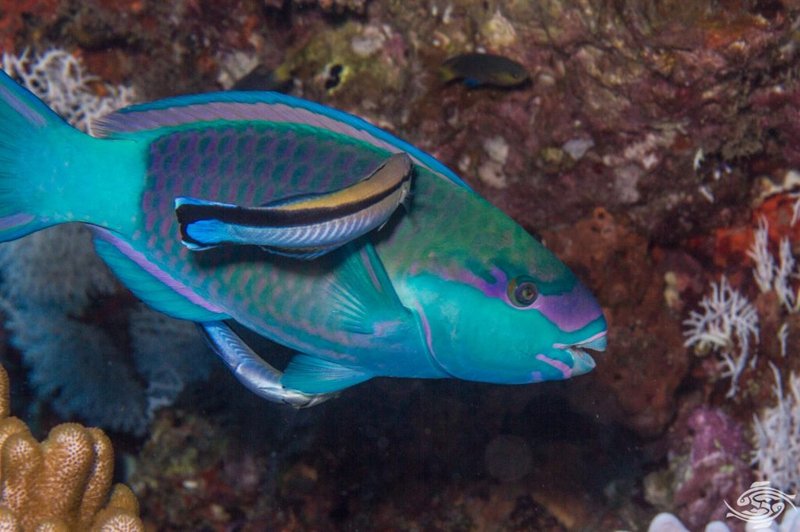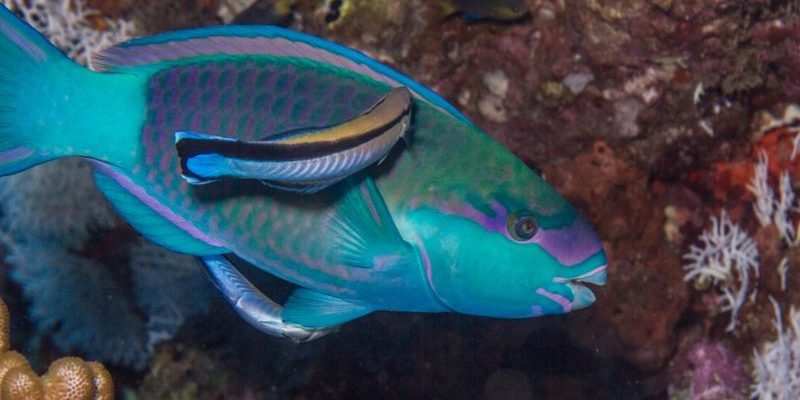
Have you ever looked into a coral reef and wondered who’s responsible for keeping it tidy? Enter the Cleaner Wrasse. This small but fascinating fish has a vital role in marine ecosystems, akin to a bustling barber shop, where clients come in for a refreshing clean-up. Just like how you might visit your favorite stylist to spruce up your look, larger fish frequent Cleaner Wrasses to get rid of pesky parasites and dead skin. They are nature’s little sanitizers, and their service is both appreciated and essential.
You might be asking yourself, “What exactly do Cleaner Wrasses do?” Well, they provide an important service to other fish by removing harmful parasites and bacteria. This not only helps keep their clients healthy but also fosters a symbiotic relationship that benefits both parties. Imagine a world where you and your friends depend on each other for help—this is sort of like that, but underwater! Let’s dive a bit deeper into the captivating world of the Cleaner Wrasse.
What is a Cleaner Wrasse?
The Cleaner Wrasse is a small, colorful fish typically found in tropical reefs around the world. With their vibrant hues and lively movements, they stand out among the more drab inhabitants of the sea. Measuring about 4 to 5 inches in length, these fish often sport a stunning blue and yellow coloration, which helps them attract fish that need their services. Imagine walking into a room filled with dull colors—then suddenly, a burst of bright color appears! That’s what a Cleaner Wrasse brings to the underwater scene.
These little guys belong to the family Labridae, and they’re known for their unique behavior of “cleaning” other fish. You see, they set up “cleaning stations” where larger fish will visit, hoping for a nice scrubdown. This is a form of mutualism—a win-win situation where both species benefit from the interaction. The Cleaner Wrasse gets a meal, while the larger fish get relief from those annoying parasites. It’s one of those rare and beautiful examples of nature working together.
The Cleaner Wrasse is also a fascinating species because of its intelligence. They can recognize individual fish and remember them over time, showcasing a level of cognitive ability not commonly found in many other fish. They are not just colorful; they’re smart too! This ability to learn and adapt helps them maintain their business in the bustling underwater marketplace of cleaning stations.
Habitat of Cleaner Wrasse
You’ll often find Cleaner Wrasses in the warm, shallow waters of coral reefs, usually at a depth of around 10 to 50 meters. These reefs provide not just shelter but also a rich habitat filled with potential clients. Think of the reef as a busy city where every fish has a role, and Cleaner Wrasses serve as the dedicated health professionals keeping everyone in tip-top shape.
The corals themselves provide hiding spots and nesting areas, which is crucial for their survival. Being small and colorful, Cleaner Wrasses must be cautious of predators. In the reef ecosystem, they navigate through coral branches and crevices, darting in and out to avoid larger fish who might see them as a snack. It’s a bit like playing hide-and-seek in a maze—one must be clever and quick!
Interestingly, the presence of Cleaner Wrasses can indicate a healthy reef ecosystem. Their abundance often reflects the overall health of the coral reefs they inhabit. So, if you ever get a chance to snorkel or dive around a reef and spot these little cleaners, you can feel good knowing that you’re looking at a thriving underwater community.
Diet of Cleaner Wrasse
Now, let’s talk food! What do Cleaner Wrasses eat? Their diet mainly consists of parasites, dead skin, and other organic matter found on larger fish. This is where things get really interesting. Imagine going to your favorite restaurant where you can order not just food, but also a spa treatment! That’s what Cleaner Wrasses do. They feast on the small pests that bother other fish, effectively providing a cleaning service while getting a meal.
When a larger fish approaches a cleaning station, Cleaner Wrasses often perform an elaborate dance to signal their intent. They wave, hover, and even change colors to attract their clients. It’s not just about the food; it’s a whole show! The larger fish trust that these little cleaners won’t harm them, which is essential for their ongoing relationship. This trust allows Cleaner Wrasses to efficiently do their job without fear of being misunderstood or seen as a threat.
Due to their specialized diet, Cleaner Wrasses play a critical role in maintaining the health of fish populations. By removing parasites, they help reduce the spread of diseases among marine life. This delicate balance keeps the underwater world a healthy and vibrant place, which is essential for both fish and the overall ecosystem. So next time you come across a Cleaner Wrasse, remember—they are more than just pretty fish; they are vital health providers of the ocean!
Behavior and Social Structure
The behavior of Cleaner Wrasses is, in many ways, as fascinating as their physical appearance. These fish have unique social structures and interactions that make their cleaning stations a hotspot for marine life. When they’re not busy cleaning, you can often find them swimming in small groups, darting among the corals and occasionally engaging in playful antics. It’s like watching a group of friends just hanging out together, having fun while looking for their next “client.”
Interestingly, Cleaner Wrasses have been observed using their color changes not only to attract clients but also to communicate among themselves. They might display different colors to signal danger or to warn others of potential threats nearby. It’s a form of underwater signaling that demonstrates their intelligence and adaptability. Talk about using fashion for a purpose!
One unique aspect of their behavior is how they handle competition. When multiple Cleaner Wrasses set up shop near each other, they have to be strategic about who gets to clean which fish. They often use size and color patterns to determine which fish is theirs. If you think about it, it’s a bit like a busy salon where stylists must negotiate who gets which client next. This behavior not only highlights their social structures but showcases their ability to adapt to their environment to ensure everyone can succeed.
Reproduction and Lifespan
The reproductive habits of the Cleaner Wrasse are quite fascinating. During mating season, these fish engage in elaborate courtship displays. Males often perform a series of dance-like movements to attract females, showcasing their vibrant colors and agility. Once a female is interested, they may engage in synchronized swimming, a mesmerizing sight for any fortunate observer. It’s a romantic dance that mirrors the beauty of life underwater.
After mating, the female Cleaner Wrasse lays eggs in hidden crevices within the coral reefs. These eggs are usually scattered in small clusters to avoid detection from predators. The eggs hatch after several days, releasing tiny larvae into the water. This early stage of life is filled with danger, as many marine creatures view these vulnerable larvae as a tasty snack. The survival rate is low, but those that make it will grow and eventually find their place among the coral reefs.
As for lifespan, Cleaner Wrasses typically live around 4 to 5 years in the wild. However, in protected environments like aquariums, some have been known to live longer. Just like your favorite childhood toy that you kept in pristine condition, a Cleaner Wrasse in a safe environment will flourish and reach its full potential. Their complex life cycle, from tiny larvae to vibrant adults, mirrors the delicate balance of life in our oceans.
Conservation Status
As much as Cleaner Wrasses are beloved, they face threats, much like other marine species. Overfishing, habitat destruction, and climate change pose significant challenges to their populations. Cleaner Wrasses often fall victim to the aquarium trade, where their colorful appearance makes them a desirable catch. Unfortunately, collecting these fish can lead to population declines, disrupting the crucial cleaning services they provide in the ecosystem.
Efforts are underway to protect their habitats, especially coral reefs around the globe. Preserving these ecosystems is essential for the survival of Cleaner Wrasses and countless other marine species. Think of coral reefs as bustling cities; if they start to crumble, the people (or fish, in this case) suffer. Through awareness, sustainable fishing practices, and habitat protection, we can help ensure that Cleaner Wrasses thrive for future generations.
Conservation organizations are also working to promote responsible aquarium practices, ensuring that the collection of Cleaner Wrasses does not harm their populations. When we make conscious choices about our seafood and aquarium pets, we can contribute to the health of our oceans. Like supporting your local community, every small action counts in making a difference!
Interesting Facts About Cleaner Wrasse
| Scientific Name: | Labroides dimidiatus |
| Size: | 4 to 5 inches (10 to 13 cm) |
| Habitat: | Tropical coral reefs |
| Diet: | Parasites, dead skin, organic matter |
| Lifespan: | 4 to 5 years in the wild |
| Behavior: | Mutualism with larger fish |
| Reproduction: | Eggs laid in coral crevices |
FAQ
Why are Cleaner Wrasses important for marine ecosystems?
Cleaner Wrasses play a crucial role in marine ecosystems by removing parasites and dead skin from larger fish. This service not only helps keep the larger fish healthy but also improves the overall health of the reef ecosystem. Without these little cleaners, fish populations could suffer from increased diseases, leading to a decline in biodiversity.
Can Cleaner Wrasses be kept in aquariums?
Yes, Cleaner Wrasses can be kept in aquariums, but there are important considerations. They require specific tank conditions, including space and suitable tank mates, as they can sometimes be territorial. Additionally, ensuring they have enough to clean and interact with can be challenging in a controlled environment.
What do Cleaner Wrasses do when they clean other fish?
When Cleaner Wrasses clean other fish, they perform a series of delicate movements, removing parasites and dead skin. They often signal their intent through colorful displays and unique motions to make the larger fish feel safe and welcomed. This process is mutually beneficial, as both species gain from the interaction.
How do Cleaner Wrasses communicate?
Cleaner Wrasses use a mix of color changes and body movements to communicate. They display different hues to signal danger or attract fish to cleaning stations. This non-verbal communication showcases their intelligence and ability to adapt to their surroundings.
What threats do Cleaner Wrasses face?
Cleaner Wrasses face several threats, including overfishing, habitat destruction, and climate change. Their vibrant colors make them a target for the aquarium trade, which can lead to population declines. Protecting their habitats and promoting sustainable practices are essential for their survival.
How can I help protect Cleaner Wrasses?
You can help protect Cleaner Wrasses by supporting sustainable seafood and aquarium practices. Choosing responsibly sourced seafood and being mindful of your aquarium pet choices can significantly reduce the impact on their populations. Awareness and education about marine conservation also play a vital role in their protection.
What is mutualism in relation to Cleaner Wrasses?
Mutualism is a symbiotic relationship where both parties benefit from the interaction. In the case of Cleaner Wrasses, they provide cleaning services to larger fish, which in turn offers the Cleaner Wrasse a source of food. This type of relationship fosters a healthy ecosystem and is a fascinating aspect of their behavior.

